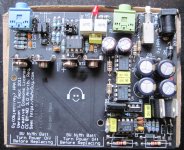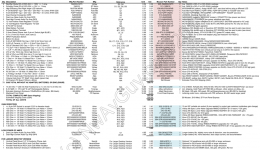I have a quick question. The board I got from the Fall 2011 group buy of the last and latest v1.1 Sept release seems to have smaller holes for the J1 kobiconn DC jack. Has anyone else experienced this issue before?
It seems like the only choice I have right now is to somehow trim the very hard lead so it can fit in. To confirm, if I do so, I should make sure that one side of th lead is always touching one side of the PCB so it is making contact correct? Would it be bad if it didn't?
It seems like the only choice I have right now is to somehow trim the very hard lead so it can fit in. To confirm, if I do so, I should make sure that one side of th lead is always touching one side of the PCB so it is making contact correct? Would it be bad if it didn't?
I recall RS answering this (or something similar) for another member earlier in the thread. You should be able to trim the lead with diagonal cutters. As to your latter questions, do you mean the lead making contact with the plated hole? That isn't absolutely necessary; the connection only needs to conduct the AC. For peace of mind you could bend the jack leads slightly in different directions. That should give the best possible mechanical connection, but you'll probably have a little harder time getting all the pins in the holes. Another instance when a small flathead screwdriver comes in very handy, to push the lead over just enough to fully insert the part.
I have finished my O2 and its not working properly. The sound coming out is quiet, distorted and echo-y.
I have done all the voltage checks and the power supply section is fine. There appear to be no solder bridges. The only thing i can think of is that the voltage coming out of P2 is 4.2 mV in the bottom 2 pins when its meant to be 8 mV. This is exactly the same as what comes out of op-amp U2/U3.
I think it could be something wrong with the op-amps although i could be wrong.
Any help would be great!
THanks
I have done all the voltage checks and the power supply section is fine. There appear to be no solder bridges. The only thing i can think of is that the voltage coming out of P2 is 4.2 mV in the bottom 2 pins when its meant to be 8 mV. This is exactly the same as what comes out of op-amp U2/U3.
I think it could be something wrong with the op-amps although i could be wrong.
Any help would be great!
THanks
O2 with PC mother board style jumpers
Sincere apologies to O2 purists, actually I didn't followed the exact BOM
This is just to show you an O2 with PC mother board style jumpers for vol.(next project-panel mounted stepped attenuator),gain, i/p & o/p.
Prime reason for using jumpers was to avoid accidental pressing of gain switch in my pocket. I'm planning to use PC CDROM type audio connectors for all connections. BTW All resistors are 1/4th watt .
.
I'm using 12VAC adapter that came with Creative spk. Even old dial-up modem AC-adapters will also work with O2.
Sincere apologies to O2 purists, actually I didn't followed the exact BOM
This is just to show you an O2 with PC mother board style jumpers for vol.(next project-panel mounted stepped attenuator),gain, i/p & o/p.
Prime reason for using jumpers was to avoid accidental pressing of gain switch in my pocket. I'm planning to use PC CDROM type audio connectors for all connections. BTW All resistors are 1/4th watt
I'm using 12VAC adapter that came with Creative spk. Even old dial-up modem AC-adapters will also work with O2.
Attachments
Last edited:
I'll be building this amplifier, what is the recommended part list if I want this to be my last amp?
All the details at-
NwAvGuy: O2 Details
Step by step guide-
http://www.diyaudio.com/forums/headphone-systems/217086-building-o2-headphone-amp.html
Ordering straight from Mouser is expensive(S&H 40$).
You can buy kits from jtktam (Audio Poutine) or swalter (Head n' Hifi) or many other GB. BOM is pretty standard, all you will be needing are couple of extra gain resistors ,suitable front panel & enclosure.
If you are not experienced builder maybe reading all the 3149 comments (incl. this)will definitely prove useful
Attachments
Last edited:
Thanks, any recommended op amps?All the details at-
NwAvGuy: O2 Details
Step by step guide-
http://www.diyaudio.com/forums/headphone-systems/217086-building-o2-headphone-amp.html
Ordering straight from Mouser is expensive(S&H 40$).
You can buy kits from jtktam (Audio Poutine) or swalter (Head n' Hifi) or many other GB. BOM is pretty standard, all you will be needing are couple of extra gain resistors ,suitable front panel & enclosure.
If you are not experienced builder maybe reading all the 3149 comments (incl. this)will definitely prove useful
Thanks, any recommended op amps?
JRC4556AD for driving headphones & JRC2068D for gains <6.5X bat. operation or NE5532 >6.5X AC operation(I'm using only these opamps). Other opamps for lo-power ver. are mentioned in BOM but have inferior audio specs.
"NJM4556 OP AMPS: The NJM4556 op amps, by far, work the best in this design. No other dual DIP8 op amp can deliver even close to as much current at as low of distortion. Few op amps are made for driving headphones but the NJM4556 is. It also works well paralleled and not all op amps do. The TLC2062 is an acceptable substitute for headphones 32 ohms or higher and also provides about 3 times longer battery life. See: Low Power Option. The RC4580 is a very distant third if have no other choice.
NJM2068/NE5532: If you’re mainly going to run the O2 from battery I strongly recommend the NJM2068 as it reduces the overall idle power consumption about 13% significantly helping battery life. At 2.5X or 3X gain there’s no difference in distortion performance between the NJM2068 and any other op amp I tried and it’s generally quieter. But, at the 6.5X gain setting, you can get a slight reduction in high frequency distortion from about 0.0018% to 0.0010% switching to the NE5532. Anything below 0.01% is very likely inaudible and both are well under that threshold. But the NE5532 is 3 dB noisier and shortens battery life. Anything more expensive than the NJM5532 is not only a waste of money but some very fast op amps may have stability problems, require different compensation, etc. See the Op Amp Measurements article."
NwAvGuy: O2 Details
Last edited:
I have finished my O2 and its not working properly. The sound coming out is quiet, distorted and echo-y.
I have done all the voltage checks and the power supply section is fine. There appear to be no solder bridges. The only thing i can think of is that the voltage coming out of P2 is 4.2 mV in the bottom 2 pins when its meant to be 8 mV. This is exactly the same as what comes out of op-amp U2/U3.
I think it could be something wrong with the op-amps although i could be wrong.
Any help would be great!
THanks
Can you take a picture from top and bottom?
Stefan
Hey guys I joined the clubI purchased a JDS Labs O2/Odac combo second hand, and he also included a NE5532 and a LM4562 opamp with the existing 2068. The unit has 1X/2.5X gains and is driving my DT-770 Pro 80's. Which opamp do you guys recommend I use? Thanks.
Use the existing JRC NJM2068D that you have as well as the JRC NJM4556AD if that's included too.
Out of curiosity, did rocketscientist ever address why he doesn't recommend the njm4562 in the gain position?
"LM4562/LME49860/LME49720 – National had a dedicated team of high-end audio engineers and they turned out some really great parts. The most popular are these op amps which have found their way into a lot of high-end audiophile blessed gear. The LM4562 and its siblings, in any headphone or DAC application I can imagine, should match any of the elite parts above. That’s objectively on an audio analyzer using the conventional suite of audio tests and subjectively in blind listening tests. The LM4562 was the first op amp to unseat the NE5532 as Doug Self’s overall benchmark. The LM4562 is electrically identical to the LME49720 but cheaper ($3) and comes in a DIY friendly DIP8 package. Samuel Groner did raise some common mode concerns with the LM4562 depending on how it’s configured. Doug Self, who also tested it in some similar configurations, seems less concerned.
*NJM4562 – How about a $3 LM4562 (see above) for $1? That’s pretty much what you get with the NJM4562. My measurements show the two to be very similar with the NJM version even needing less quiescent current. It has slightly more noise than the 2068 above but can better drive low impedance loads, with lower high frequency distortion, at higher gains. For gains < 4X into “easy” (non-reactive) loads of 2K or higher, the NJM2068 is the better part. If you’d rather have the Audi A3 over the very similar but much cheaper Volkswagen GTI, get the National part, otherwise save some money with the NJM4562
GIANT KILLER: The following op amp deserves its own category:
*NE5532 – The NE5532, as mentioned in the last article, was originally developed by Signetics mainly for audio use. At the time it, for audio applications, it was like comparing a modern day Ferrari to an old Volkswagen Beetle. It really wasn’t until the LM4562 (see above) came along there was much reason to use anything else for most consumer audio applications—especially if you exclude microphone and phono preamps. There are op amps with better DC specs, faster settling times, higher slew rates, lower offsets, etc. But none of those improvements help 99% of audio gear perform any better. And those “partly better” parts are often worse in more critical areas. The 5532 is the corner stone of nearly all high-end professional audio gear which means most of your music has already been well steeped in 5532 goodness. If you dislike the “sound” of 5532 that means you must also dislike most of the music available."
http://nwavguy.blogspot.in/2011_08_01_archive.html
There's a pic of the grounded case somewhere in this thread. I think agdr posted it. I'll try to describe mine in less than 1000 words.
First I did a little filing around the screw hole in the case, to make good contact. I used one of the thinner component leads, probably cut from a capacitor, and I soldered one end to the input ground on the bottom-side of the board. Then I used long-nosed pliers to bend the lead over to the screw hole in the case. I made a partial loop there around the screw hole and cut off the excess. The component lead is rigid enough to stay in place, so assembly is easy with the ground lead where it needs to be.
edit: ah-ha!! Here it is, in 6L6's build thread. The very first (and second) post!
First I did a little filing around the screw hole in the case, to make good contact. I used one of the thinner component leads, probably cut from a capacitor, and I soldered one end to the input ground on the bottom-side of the board. Then I used long-nosed pliers to bend the lead over to the screw hole in the case. I made a partial loop there around the screw hole and cut off the excess. The component lead is rigid enough to stay in place, so assembly is easy with the ground lead where it needs to be.
edit: ah-ha!! Here it is, in 6L6's build thread. The very first (and second) post!
Last edited:
- Home
- Amplifiers
- Headphone Systems
- The Objective2 (O2) Headphone Amp DIY Project


